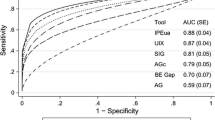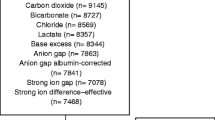Abstract
Purpose
To examine the repeatability of Stewart’s parameters and anion gap in a cohort of critically ill patients and to determine the smallest detectable changes in individual patients.
Methods
A total of 161 patients were included prospectively. They underwent two subsequent blood samplings within 10 min of each other and samples were analyzed using the same central laboratory analyzer. Measured and calculated parameters from the two samples were compared. The repeatability was expressed as the smallest detectable difference (SDD), coefficient of variation (CV) and intraclass correlation coefficient (ICC).
Results
The mean differences ± SD (mEq/L) for the repeated measurements were 0.1 ± 0.76, 0.12 ± 0.68, −0.02 ± 1.02, and −0.08 ± 1.05 for the apparent strong ion difference (SIDapp), effective strong ion difference (SIDeff), strong ion gap (SIG), and albumin-corrected anion gap (AGcorr), respectively. The SDDs (mEq/L) for SIDapp, SIDeff, SIG, and AGcorr, were ±1.49, ±1.33, ±2, and ±2.06, respectively. The CVs (%) for these variables were 1.4, 1.45, 13.3, and 4.15, respectively. The ICCs for all these variables were high, largely above 0.75.
Conclusions
The repeatability of all these calculated variables was good. In repeated measurements, a change in value of these parameters exceeding 1.96√2 CV (%), the least significant change (LSC) or the SDD should be regarded as significant. Use of SDD is preferable to CV and LSC (%) because of its independence from the levels of variables and its expression in absolute units. Expressed as SDD, a SIG change value, e.g., of at least ±2 mEq/L should be significant.



Similar content being viewed by others
Abbreviations
- AG:
-
Anion gap
- AGcorr :
-
Albumin-corrected anion gap
- CV:
-
Within subject coefficient of variation
- ICC:
-
Intraclass correlation coefficient
- ICU:
-
Intensive care unit
- LSC:
-
Least significant change
- SDdiff :
-
Standard deviation of the difference
- SDD:
-
Smallest detectable difference
- SIDapp :
-
Apparent strong ion difference
- SIDeff :
-
Effective strong ion difference
- SIG:
-
Strong ion gap
References
Gunnerson KJ, Kellum JA (2003) Aid-base and electrolyte analysis in critically ill patients: are we ready for the new millennium? Curr Opin Crit Care 9:468–473
Oh MS, Carroll HJ (1977) The anion gap. N Engl J Med 297:814–817
Stewart PA (1983) Modern quantitative acid-base chemistry. Can J Physiol Pharmacol 61:1444–1461
Figge J, Rossing TH, Fencl V (1991) The role of serum proteins in acid-base equilibria. J Lab Clin Med 117:453–467
Figge J, Mydosh T, Fencl V (1992) Serum proteins and acid-base equilibria: a follow-up. J Lab Clin Med 120:713–719
Moviat M, Van Haren F, van der Hoeven H (2003) Conventional or physicochemical approach in intensive care unit patients with metabolic acidosis. Crit Care 7:R41–R45
Boniatti MM, Cardoso PR, Castilho RK, Vieira SR (2009) Acid-base disorders evaluation in critically ill patients: we can improve our diagnostic ability. Intensive Care Med 35:1377–1382
Nguyen BV, Vincent JL, Hamm JB, Abalain JH, Carre JL, Nowak E, Ahmed MO, Arvieux CC, Gueret G (2009) The reproducibility of Stewart parameters for acid-base diagnosis using two central laboratory analyzers. Anesth Analg 109:1517–1523
White GH, Farrance I (2004) Uncertainty of measurement in quantitative medical testing: a laboratory implementation guide. Clin Biochem Rev 25:S1–24
Kellum JA, Kramer DJ, Pinsky MR (1995) Strong ion gap: a methodology for exploring unexplained anions. J Crit Care 10:51–55
Figge J, Jabor A, Kazda A, Fencl V (1998) Anion gap and hypoalbuminemia. Crit Care Med 26:1807–1810
Bland JM, Altman DG (1986) Statistical methods for assessing agreement between two methods of clinical measurement. Lancet 1:307–310
Shrout PE, Fleiss JL (1979) Intraclass correlations: uses in assessing rater reliability. Psychol Bull 86:420–428
Lodder MC, Lems WF, Ader HJ, Marthinsen AE, van Coeverden SC, Lips P, Netelenbos JC, Dijkmans BA, Roos JC (2004) Reproducibility of bone mineral density measurement in daily practice. Ann Rheum Dis 63:285–289
Glüer CC (1999) Monitoring skeletal changes by radiological techniques. J Bone Miner Res 14:1952–1962
Morimatsu H, Rocktäschel J, Bellomo R, Uchino S, Goldsmith D, Gutteridge G (2003) Comparison of point-of-care versus central laboratory measurement of electrolyte concentrations on calculations of the anion gap and the strong ion difference. Anesthesiology 98:1077–1084
British Standard Institution (1979) Precision of test methods 1: guide for the determination of repeatability and reproducibility for a standard test method, BS 5497-1. British Standard Institution, London
Bland JM, Altman DG (1990) A note on the use of the intraclass correlation coefficient in the evaluation of agreement between two methods of measurement. Comput Biol Med 20:337–340
Acknowledgments
The authors are deeply indebted to the nursing staff of the ICU for their help in this study.
Conflicts of interest
None of the authors has any potential financial conflict of interest related to this manuscript.
Author information
Authors and Affiliations
Corresponding author
Electronic supplementary material
Below is the link to the electronic supplementary material.
Rights and permissions
About this article
Cite this article
Mallat, J., Barrailler, S., Lemyze, M. et al. The repeatability of Stewart’s parameters and anion gap in a cohort of critically ill adult patients. Intensive Care Med 38, 2026–2031 (2012). https://doi.org/10.1007/s00134-012-2679-9
Received:
Accepted:
Published:
Issue Date:
DOI: https://doi.org/10.1007/s00134-012-2679-9




